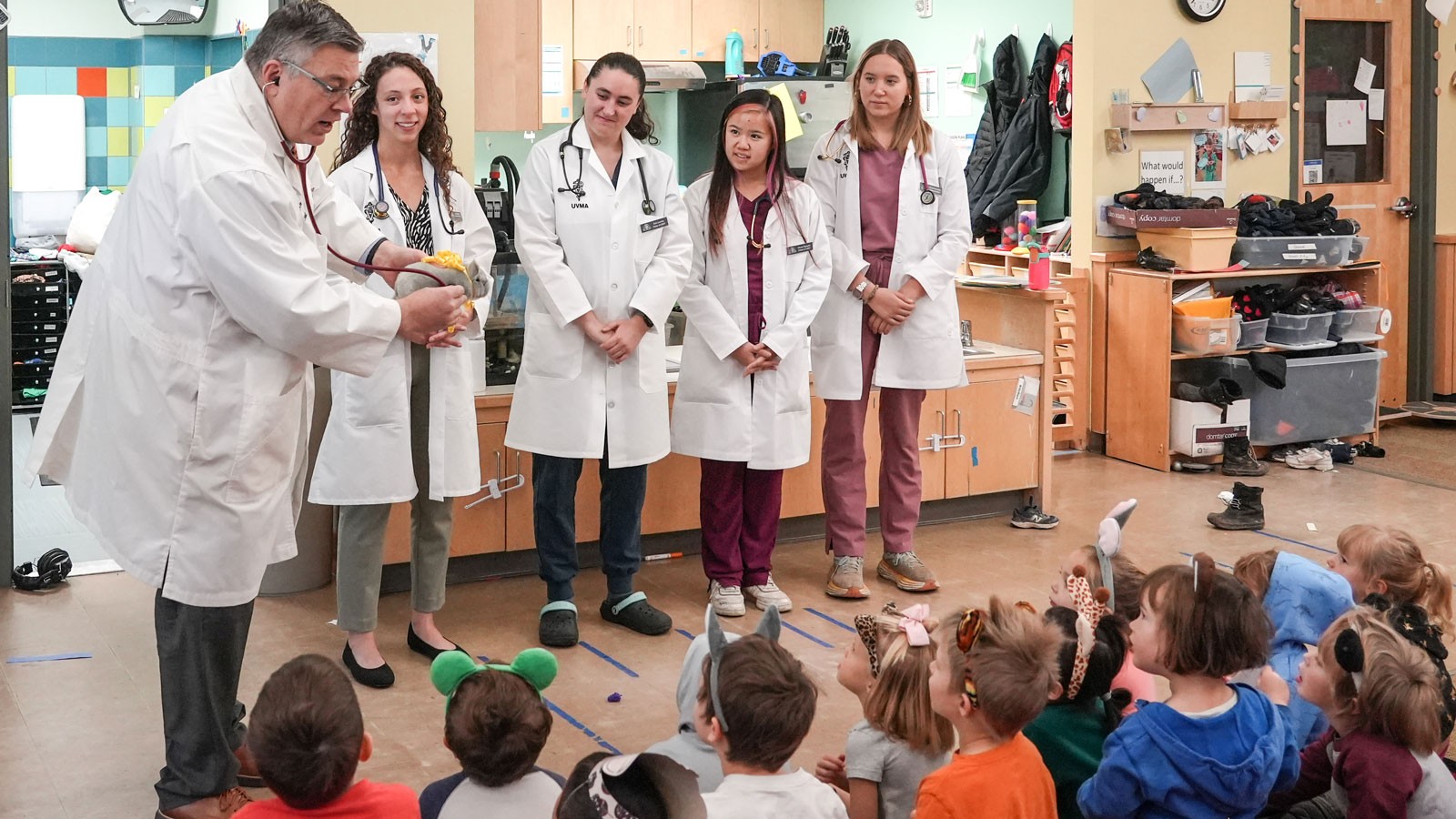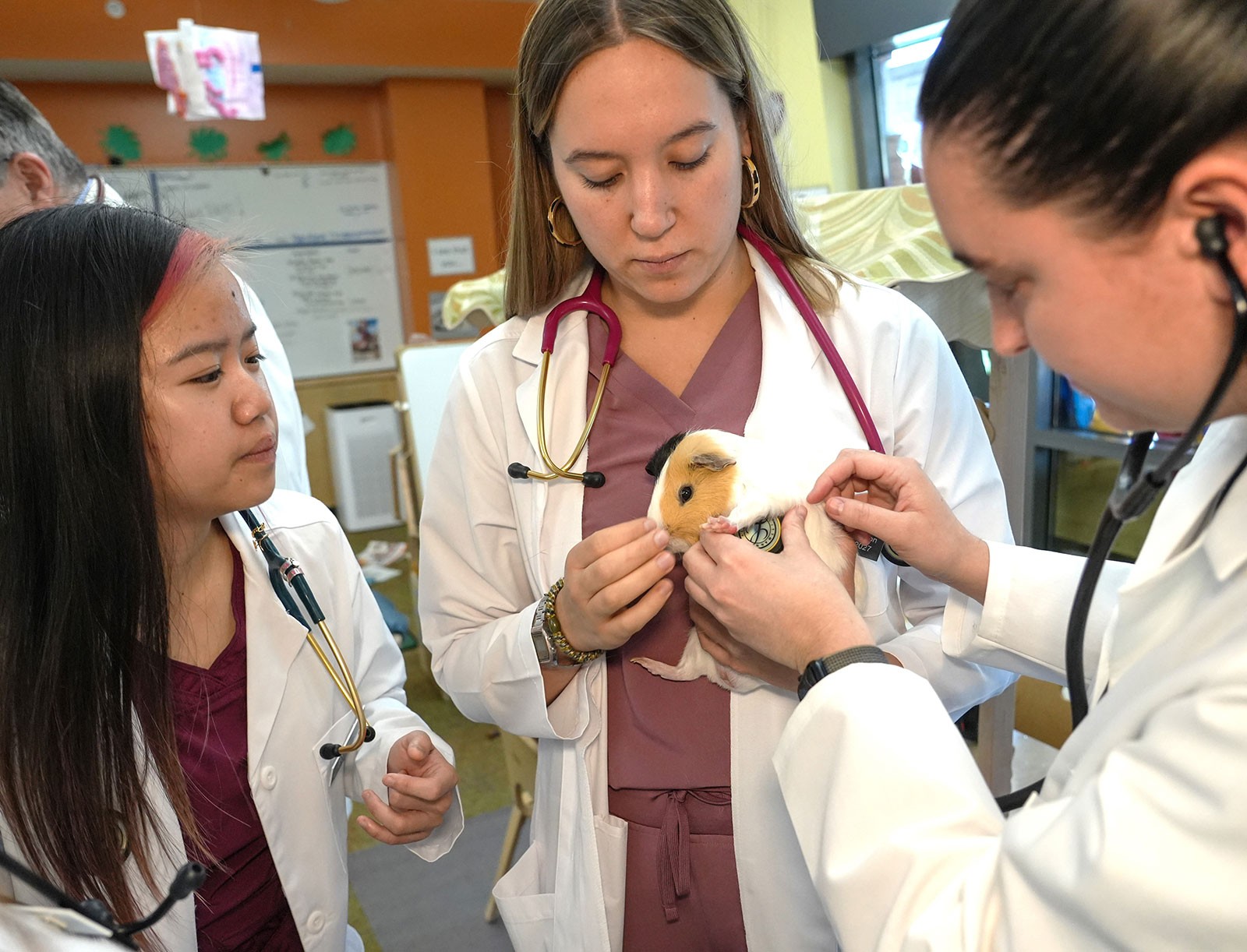Veterinarian and Vet Med Students Make Classroom Call for Pet Checkups
By Ethan Brightbill |
Dr. Kerry Rood and students from USU's Zoo, Exotic and Wildlife Club demonstrate a stethoscope on a stuffed animal to preschoolers during a visit to the Dolores Doré Eccles Center for Early Care & Education on USU's Logan campus.
When Patches the guinea pig became lethargic and lost his appetite, the children who looked forward to seeing him every day at Utah State University’s Dolores Doré Eccles Center for Early Care & Education were worried. Fortunately, Dr. Kerry Rood and members of USU’s Zoo, Exotic and Wildlife Club were there to save the day.
In a presentation to the preschoolers, Rood and ZEW Club members Julia Bartoli, Erin Levine, Paula Nguyen, and Olivia Levinson examined Patches as well as Rainbow the turtle. In the process, they transformed what could have been a simple checkup into a learning opportunity for the students of both the Dolores Doré Eccles Center and the College of Veterinary Medicine.
Rood began the visit with a plush chinchilla. After encouraging the children to name it (“Bunny!” “Rabbit!” “Goose!”), he used the toy to demonstrate what the checkup would look like and explained how small animals like guinea pigs tend to have faster heartbeats than larger animals like elephants. Then Rood and the veterinary medical students took Patches out of his cage and inspected both him and his habitat.
Bartoli, the ZEW Club’s treasurer, explained that she and her fellow students had considered Patches’ case before the visit and concluded that arthritis or vitamin C deficiency were likely behind the guinea pig’s symptoms. Once they had the chance to see him in person, it became clear that the latter was likely the culprit.
While Patches had access to healthy veggies and vitamin C supplements in his water, the supplements may have been weakened by exposure to light, and there was no way to tell how much Patches consumed. Rood recommended adding vitamin C to the guinea pig’s diet through other means.
The presentation ended with Rainbow the turtle getting a good bill of health and the children using stethoscopes to hear their own heartbeats. The kids also received coloring books and care guides for pets.
Bartoli was glad to have the chance to interact with new animals. While the ZEW Club provides opportunities to work with animals outside the college’s usual curriculum, including most recently a water buffalo, she had never examined a guinea pig or turtle before.
“This is what students hope to get through being in clubs in the College of Veterinary Medicine,” she said. “We want that hands-on clinical exposure and to apply what we’ve learned in the abstract to an actual experience.”
Working with an audience was its own reward.
“They were so excited for us to come visit and so engaged,” Bartoli said. “Helping them listen to their hearts with the stethoscopes was adorable. They’d say, ‘Oh, mine's beating really fast, mine is slow, can I listen to yours?’ It helped open the door of interest for them, whether into science or medicine or just animals in general. I think it’s something they'll remember when they're older.”
Rood, the College of Veterinary Medicine’s associate dean of clinical programming, who had visited the Dolores Doré Eccles Center for a similar check on other guinea pigs in 2017, thinks there’s value for veterinary medicine students in this sort of outreach experience.
“It’s important for veterinary students to experience the enthusiasm and excitement young children have for animals,” he said. “It provides another reason they can share when asked why they do what they do.”
Kelsey Saterfield is the senior preschool lead teacher for the Dolores Doré Eccles Center, and she believes experts from outside the classroom can have a profound effect on children.
“Presentations like this are super beneficial because the children get to learn in new ways and experience people with different specialties and banks of knowledge,” Saterfield said. “They capitalize on the wonder and excitement of childhood. I can talk about our guinea pig’s heartbeat, but they see me every day. Talking to a real vet, using their real tools, and experiencing how they work firsthand fosters curiosity and exploration for the children, and that’s our major goal.”
Developing that passion early, Rood said, is essential for cultivating the next generation of veterinarians.
“Veterinarians can have a powerful impact on the aspirations and dreams that children have,” he said. “Multiple positive experiences with professionals can impact their career choice later in life.”
Members of the Zoo, Exotic and Wildlife Club examine a classroom guinea pig at the Dolores Doré Eccles Center for Early Care & Education on USU's Logan campus. (Photo Credit: USU/Dennis Hinkamp)
WRITER
Ethan Brightbill
Writer and Marketing Assistant
College of Veterinary Medicine
Ethan.Brightbill@usu.edu
CONTACT
Kerry Rood
Veterinarian
Extension
435-797-1882
Kerry.rood@usu.edu
TOPICS
Education 332stories Hands-on Learning 211stories Animals 90stories Vet Sciences 62storiesComments and questions regarding this article may be directed to the contact person listed on this page.









